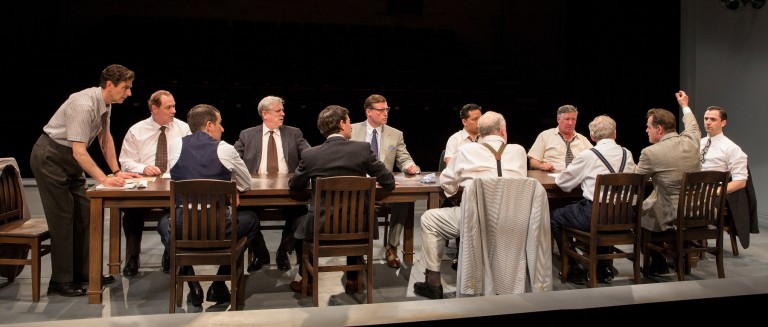Twelve Different, Complicated, Real, and Angry Men ~ Natalie Dewan

In the playbill for Soulpepper’s current production of Twelve Angry Men, the actor William Webster reflects on the unfortunate fact of wrongful convictions, in playwright Reginald Rose’s time and in our own. His reflection ends with a reminder of Rubin “Hurricane” Carter’s strength in the face of his wrongful incarceration: “He shared his moral and spiritual strength with us here in Toronto and we are the better for it. Who we are now is not who we were then.”
While I certainly agree with Webster that many promising changes have been made since the 1950s, I think the real lesson of Twelve Angry Men is that who we were then is exactly who we are now. The twelve jurors of the title are a startlingly representative sample of the people one encounters in everyday life.

Let’s take, for example, Juror 10…the brash, bigoted, stubborn white guy who is completely convinced that the accused, a sixteen-year-old kid from a bad neighbourhood, must be guilty of murder. He talks frequently about “those kinds of people”:
Look, these people are drinking and fighting all the time, and if somebody gets killed, so somebody gets killed. They don’t care. Oh, sure, there are some good things about them, too. Look, I’m the first to say that… I’ve known a few who were pretty decent, but that’s the exception. Most of them; it’s like they have no feelings. They can do anything.
Sound familiar? Perhaps like someone you know in your life? Or a certain Republican frontrunner? As terrifying as that particular comparison is, thankfully most people don’t talk like this. But most of us have some sort of ingrained prejudice in the back of our minds, an unconscious bias, that doesn’t go away just because we’re placed on a jury.
The truly startling thing about Twelve Angry Men is what it reminds us of: the risk of taking people like Juror 10, putting them in a room with eleven other complicated, baggage-ridden individuals, and making them decide the fate of someone else. This is not a social experiment or the premise of a sci-fi story – it’s real life. And this happens, every day…in Canada and around the world.
This play forces us to consider how our justice system really works, and the terrifying fact that the system is subject to all of the emotions, prejudices, mistakes, and complicated dynamics of any human interaction. If you’ve seen Making a Murderer (the release of which could not have coincided better with this production), or read about countless wrongful conviction cases in the U.S., Canada, and elsewhere, then this is no surprise to you. But Twelve Angry Men takes a careful, powerful look at how the system breaks down. Unlike the argument in Making a Murderer, here no one is trying to frame the accused; no one is sitting in a corner with a sinister laugh trying to make sure he goes to the chair. The outcome is simply impossibly tangled in personal biases.

While I was particularly struck by the incredible power and continual relevance of Rose’s script, a script that leaves you thinking long after the lights go up, the bigger credit does need to be given to Soulpepper’s production. Every aspect was thoughtfully and effectively carried out. The theatre was transformed into a jury room, with the audience sitting on either side, looking in as if through the windows. This setting effectively re-created the intimacy of what was originally a teleplay, although it did occasionally make aspects difficult to hear or see if the actors were facing in the opposite direction.
With the only characters twelve middle-aged white guys and one security guard, I did not expect the costumes to be anything to write home about. I was pleasantly surprised. While the twelve suits and one uniform were certainly not flashy, each one carefully did exactly what it was supposed to: told the audience something crucial about the character. The precise and logical Juror 4 wore a precise, well-arranged three-piece suit, and often meticulously cleaned his glasses. The stumbling, uncertain Juror 6 wore a wide, squat tie that made him look a bit foolish. Juror 11, the European immigrant, wore a clean-cut, well-designed suit and a bow tie that stood out among a sea of ties.
The actors, of course, completed this fine picture. It would be easy for twelve different, clearly-drawn characters to descend into stereotypes and over-the-top portrayals. These actors maintained the grounded reality of these men and the distinct character of each. Joseph Ziegler and William Webster have the most to play with, portraying the two most stubborn pro-conviction jurors, but each actor has a chance to shine in this true ensemble piece that last year won a Dora Award for Outstanding Ensemble Performance. The exception is Andre Sills, who was fantastic in Kim’s Convenience and is sadly only seen for a few short seconds here as the security guard.
Which leads me to my one wish of this production: more diverse casting. While I understand the merits of setting the piece in its original context, its continual relevance leaves the door wide open to a contemporary production that would give a more diverse group the opportunity to take on Rose’s powerful script. This play offers the audience a chance to critically reflect on human nature and society; I would love for women and people from all backgrounds (especially young people) to have the chance to see a diverse group taking part in that conversation.

News You Can Use
What: Twelve Angry Men by Reginald Rose, directed by Alan Dilworth
Who: Audiences 12 years and older
When: On stage now, until February 13, 2016
Where: Young Centre for the Performing Arts, Distillery Historic District, 50 Tank House Lane, Toronto, ON, M5A 3C4
For information and tickets: www.soulpepper.ca/performances/16_season/twelve_angry_men.aspx#overview
©2016 Natalie Dewan, Sesaya


